A Report on Strategizing International Human Resource Management
VerifiedAdded on 2020/04/07
|12
|3357
|86
Report
AI Summary
This report delves into the critical aspects of strategizing international human resource management (HRM). It emphasizes the importance of treating employees respectfully and providing positive motivation within a global context. The report explores how HRM strategies must transcend geographical boundaries, considering cultural differences and the competitive global environment. It examines key areas like sourcing, staffing, training, and employee retention, highlighting the need for HRM policies that align with the organization's overall strategy. The report addresses challenges such as workforce diversity, technological integration, and employee turnover, and it underscores the advantages of international HRM practices, including enhanced market adaptability, global knowledge acquisition, and improved international relations. The report concludes by emphasizing the significance of adaptability, flexibility, and the ability to navigate diverse perspectives to achieve organizational goals. This report provides a comprehensive overview of the complexities and opportunities inherent in managing human resources on a global scale.
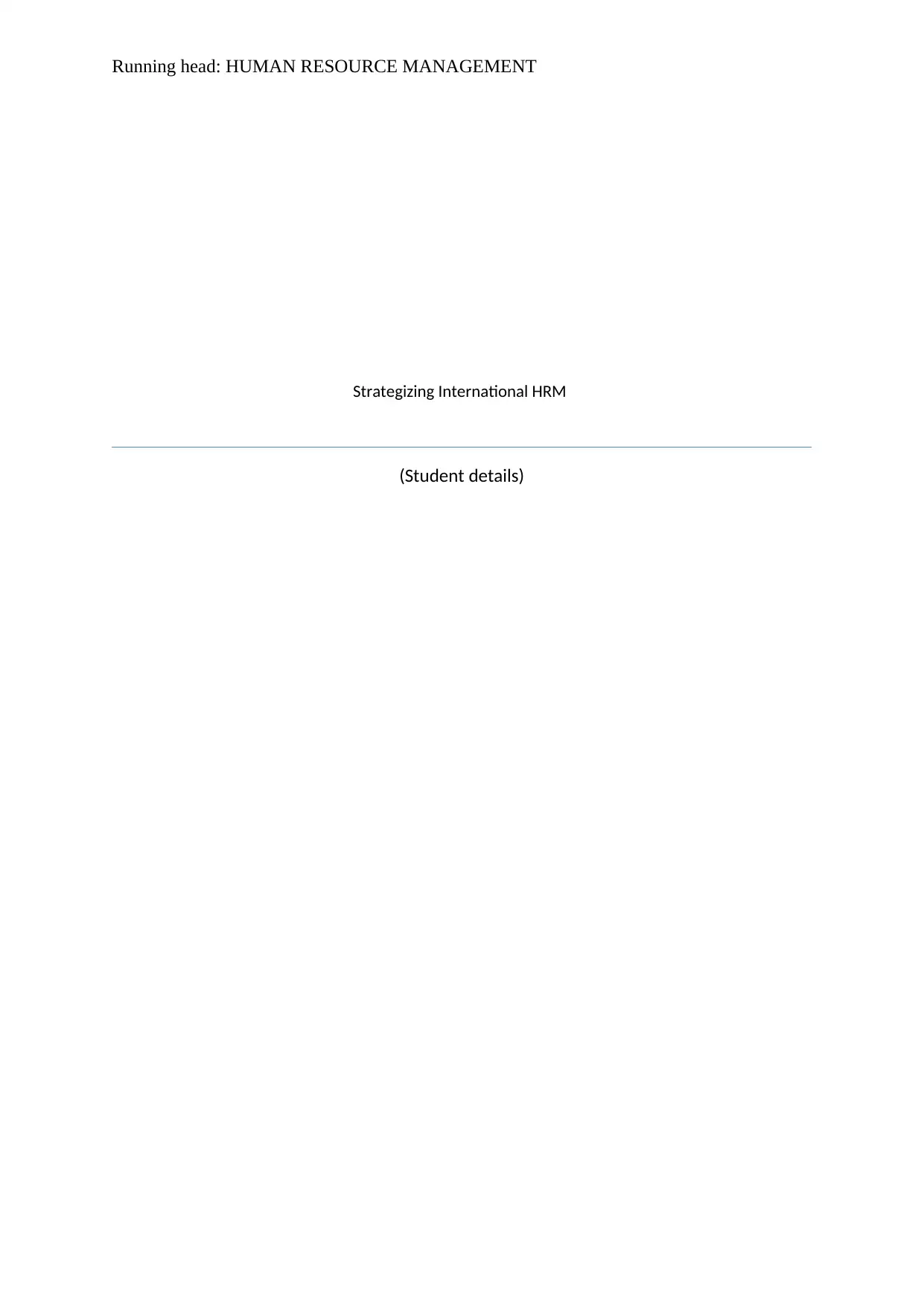
Running head: HUMAN RESOURCE MANAGEMENT
Strategizing International HRM
(Student details)
Strategizing International HRM
(Student details)
Paraphrase This Document
Need a fresh take? Get an instant paraphrase of this document with our AI Paraphraser
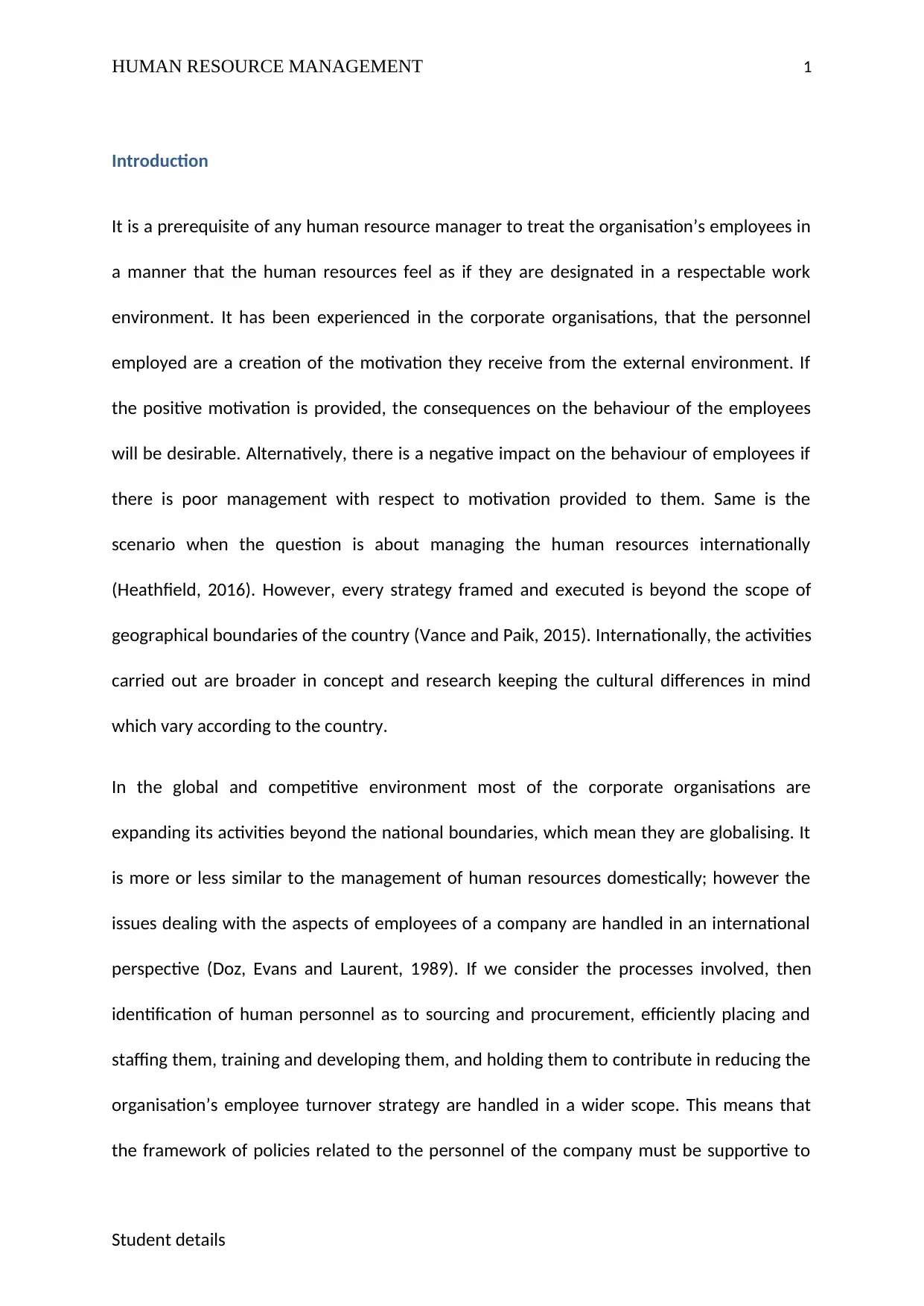
HUMAN RESOURCE MANAGEMENT 1
Introduction
It is a prerequisite of any human resource manager to treat the organisation’s employees in
a manner that the human resources feel as if they are designated in a respectable work
environment. It has been experienced in the corporate organisations, that the personnel
employed are a creation of the motivation they receive from the external environment. If
the positive motivation is provided, the consequences on the behaviour of the employees
will be desirable. Alternatively, there is a negative impact on the behaviour of employees if
there is poor management with respect to motivation provided to them. Same is the
scenario when the question is about managing the human resources internationally
(Heathfield, 2016). However, every strategy framed and executed is beyond the scope of
geographical boundaries of the country (Vance and Paik, 2015). Internationally, the activities
carried out are broader in concept and research keeping the cultural differences in mind
which vary according to the country.
In the global and competitive environment most of the corporate organisations are
expanding its activities beyond the national boundaries, which mean they are globalising. It
is more or less similar to the management of human resources domestically; however the
issues dealing with the aspects of employees of a company are handled in an international
perspective (Doz, Evans and Laurent, 1989). If we consider the processes involved, then
identification of human personnel as to sourcing and procurement, efficiently placing and
staffing them, training and developing them, and holding them to contribute in reducing the
organisation’s employee turnover strategy are handled in a wider scope. This means that
the framework of policies related to the personnel of the company must be supportive to
Student details
Introduction
It is a prerequisite of any human resource manager to treat the organisation’s employees in
a manner that the human resources feel as if they are designated in a respectable work
environment. It has been experienced in the corporate organisations, that the personnel
employed are a creation of the motivation they receive from the external environment. If
the positive motivation is provided, the consequences on the behaviour of the employees
will be desirable. Alternatively, there is a negative impact on the behaviour of employees if
there is poor management with respect to motivation provided to them. Same is the
scenario when the question is about managing the human resources internationally
(Heathfield, 2016). However, every strategy framed and executed is beyond the scope of
geographical boundaries of the country (Vance and Paik, 2015). Internationally, the activities
carried out are broader in concept and research keeping the cultural differences in mind
which vary according to the country.
In the global and competitive environment most of the corporate organisations are
expanding its activities beyond the national boundaries, which mean they are globalising. It
is more or less similar to the management of human resources domestically; however the
issues dealing with the aspects of employees of a company are handled in an international
perspective (Doz, Evans and Laurent, 1989). If we consider the processes involved, then
identification of human personnel as to sourcing and procurement, efficiently placing and
staffing them, training and developing them, and holding them to contribute in reducing the
organisation’s employee turnover strategy are handled in a wider scope. This means that
the framework of policies related to the personnel of the company must be supportive to
Student details
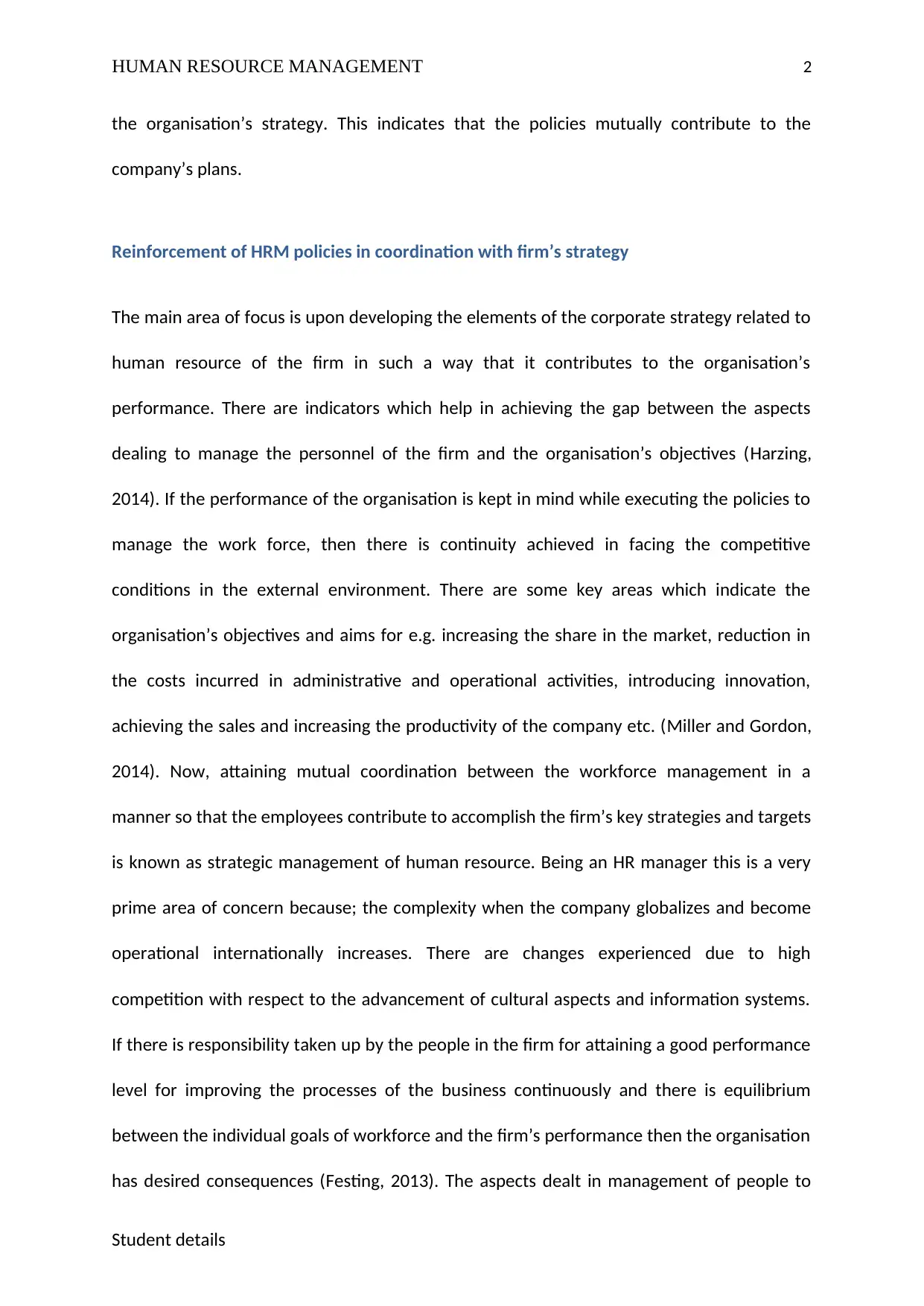
HUMAN RESOURCE MANAGEMENT 2
the organisation’s strategy. This indicates that the policies mutually contribute to the
company’s plans.
Reinforcement of HRM policies in coordination with firm’s strategy
The main area of focus is upon developing the elements of the corporate strategy related to
human resource of the firm in such a way that it contributes to the organisation’s
performance. There are indicators which help in achieving the gap between the aspects
dealing to manage the personnel of the firm and the organisation’s objectives (Harzing,
2014). If the performance of the organisation is kept in mind while executing the policies to
manage the work force, then there is continuity achieved in facing the competitive
conditions in the external environment. There are some key areas which indicate the
organisation’s objectives and aims for e.g. increasing the share in the market, reduction in
the costs incurred in administrative and operational activities, introducing innovation,
achieving the sales and increasing the productivity of the company etc. (Miller and Gordon,
2014). Now, attaining mutual coordination between the workforce management in a
manner so that the employees contribute to accomplish the firm’s key strategies and targets
is known as strategic management of human resource. Being an HR manager this is a very
prime area of concern because; the complexity when the company globalizes and become
operational internationally increases. There are changes experienced due to high
competition with respect to the advancement of cultural aspects and information systems.
If there is responsibility taken up by the people in the firm for attaining a good performance
level for improving the processes of the business continuously and there is equilibrium
between the individual goals of workforce and the firm’s performance then the organisation
has desired consequences (Festing, 2013). The aspects dealt in management of people to
Student details
the organisation’s strategy. This indicates that the policies mutually contribute to the
company’s plans.
Reinforcement of HRM policies in coordination with firm’s strategy
The main area of focus is upon developing the elements of the corporate strategy related to
human resource of the firm in such a way that it contributes to the organisation’s
performance. There are indicators which help in achieving the gap between the aspects
dealing to manage the personnel of the firm and the organisation’s objectives (Harzing,
2014). If the performance of the organisation is kept in mind while executing the policies to
manage the work force, then there is continuity achieved in facing the competitive
conditions in the external environment. There are some key areas which indicate the
organisation’s objectives and aims for e.g. increasing the share in the market, reduction in
the costs incurred in administrative and operational activities, introducing innovation,
achieving the sales and increasing the productivity of the company etc. (Miller and Gordon,
2014). Now, attaining mutual coordination between the workforce management in a
manner so that the employees contribute to accomplish the firm’s key strategies and targets
is known as strategic management of human resource. Being an HR manager this is a very
prime area of concern because; the complexity when the company globalizes and become
operational internationally increases. There are changes experienced due to high
competition with respect to the advancement of cultural aspects and information systems.
If there is responsibility taken up by the people in the firm for attaining a good performance
level for improving the processes of the business continuously and there is equilibrium
between the individual goals of workforce and the firm’s performance then the organisation
has desired consequences (Festing, 2013). The aspects dealt in management of people to
Student details
⊘ This is a preview!⊘
Do you want full access?
Subscribe today to unlock all pages.

Trusted by 1+ million students worldwide
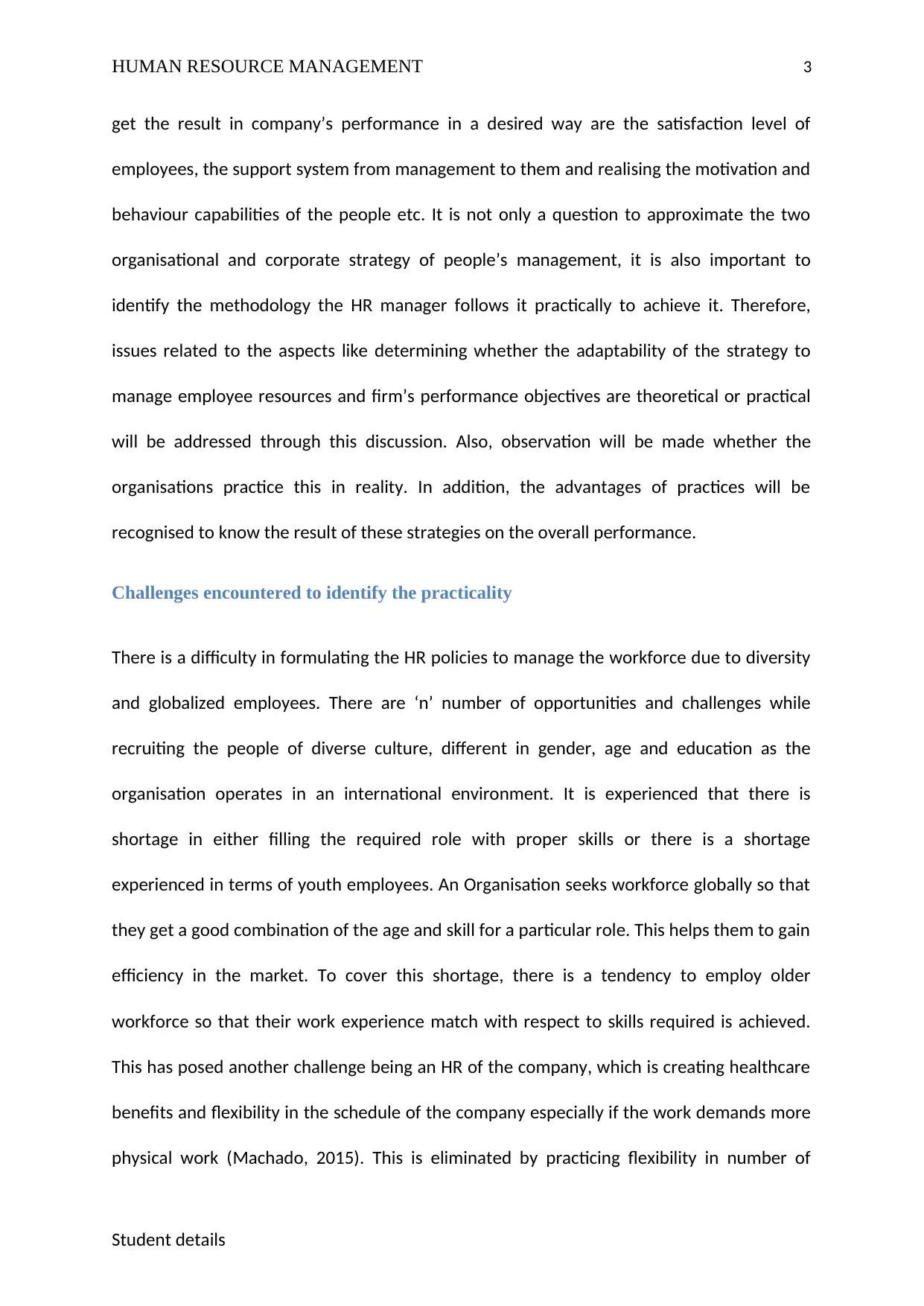
HUMAN RESOURCE MANAGEMENT 3
get the result in company’s performance in a desired way are the satisfaction level of
employees, the support system from management to them and realising the motivation and
behaviour capabilities of the people etc. It is not only a question to approximate the two
organisational and corporate strategy of people’s management, it is also important to
identify the methodology the HR manager follows it practically to achieve it. Therefore,
issues related to the aspects like determining whether the adaptability of the strategy to
manage employee resources and firm’s performance objectives are theoretical or practical
will be addressed through this discussion. Also, observation will be made whether the
organisations practice this in reality. In addition, the advantages of practices will be
recognised to know the result of these strategies on the overall performance.
Challenges encountered to identify the practicality
There is a difficulty in formulating the HR policies to manage the workforce due to diversity
and globalized employees. There are ‘n’ number of opportunities and challenges while
recruiting the people of diverse culture, different in gender, age and education as the
organisation operates in an international environment. It is experienced that there is
shortage in either filling the required role with proper skills or there is a shortage
experienced in terms of youth employees. An Organisation seeks workforce globally so that
they get a good combination of the age and skill for a particular role. This helps them to gain
efficiency in the market. To cover this shortage, there is a tendency to employ older
workforce so that their work experience match with respect to skills required is achieved.
This has posed another challenge being an HR of the company, which is creating healthcare
benefits and flexibility in the schedule of the company especially if the work demands more
physical work (Machado, 2015). This is eliminated by practicing flexibility in number of
Student details
get the result in company’s performance in a desired way are the satisfaction level of
employees, the support system from management to them and realising the motivation and
behaviour capabilities of the people etc. It is not only a question to approximate the two
organisational and corporate strategy of people’s management, it is also important to
identify the methodology the HR manager follows it practically to achieve it. Therefore,
issues related to the aspects like determining whether the adaptability of the strategy to
manage employee resources and firm’s performance objectives are theoretical or practical
will be addressed through this discussion. Also, observation will be made whether the
organisations practice this in reality. In addition, the advantages of practices will be
recognised to know the result of these strategies on the overall performance.
Challenges encountered to identify the practicality
There is a difficulty in formulating the HR policies to manage the workforce due to diversity
and globalized employees. There are ‘n’ number of opportunities and challenges while
recruiting the people of diverse culture, different in gender, age and education as the
organisation operates in an international environment. It is experienced that there is
shortage in either filling the required role with proper skills or there is a shortage
experienced in terms of youth employees. An Organisation seeks workforce globally so that
they get a good combination of the age and skill for a particular role. This helps them to gain
efficiency in the market. To cover this shortage, there is a tendency to employ older
workforce so that their work experience match with respect to skills required is achieved.
This has posed another challenge being an HR of the company, which is creating healthcare
benefits and flexibility in the schedule of the company especially if the work demands more
physical work (Machado, 2015). This is eliminated by practicing flexibility in number of
Student details
Paraphrase This Document
Need a fresh take? Get an instant paraphrase of this document with our AI Paraphraser
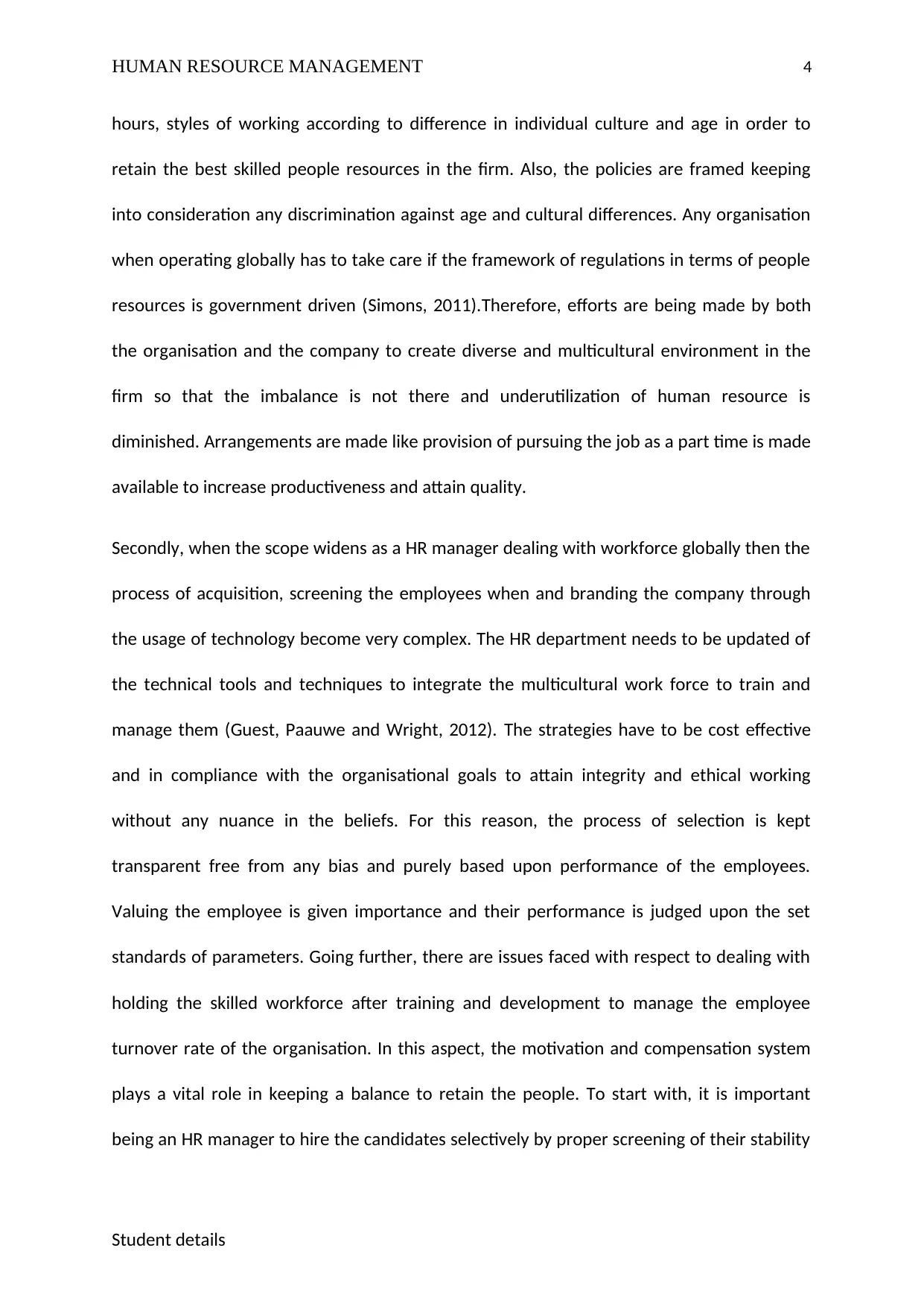
HUMAN RESOURCE MANAGEMENT 4
hours, styles of working according to difference in individual culture and age in order to
retain the best skilled people resources in the firm. Also, the policies are framed keeping
into consideration any discrimination against age and cultural differences. Any organisation
when operating globally has to take care if the framework of regulations in terms of people
resources is government driven (Simons, 2011).Therefore, efforts are being made by both
the organisation and the company to create diverse and multicultural environment in the
firm so that the imbalance is not there and underutilization of human resource is
diminished. Arrangements are made like provision of pursuing the job as a part time is made
available to increase productiveness and attain quality.
Secondly, when the scope widens as a HR manager dealing with workforce globally then the
process of acquisition, screening the employees when and branding the company through
the usage of technology become very complex. The HR department needs to be updated of
the technical tools and techniques to integrate the multicultural work force to train and
manage them (Guest, Paauwe and Wright, 2012). The strategies have to be cost effective
and in compliance with the organisational goals to attain integrity and ethical working
without any nuance in the beliefs. For this reason, the process of selection is kept
transparent free from any bias and purely based upon performance of the employees.
Valuing the employee is given importance and their performance is judged upon the set
standards of parameters. Going further, there are issues faced with respect to dealing with
holding the skilled workforce after training and development to manage the employee
turnover rate of the organisation. In this aspect, the motivation and compensation system
plays a vital role in keeping a balance to retain the people. To start with, it is important
being an HR manager to hire the candidates selectively by proper screening of their stability
Student details
hours, styles of working according to difference in individual culture and age in order to
retain the best skilled people resources in the firm. Also, the policies are framed keeping
into consideration any discrimination against age and cultural differences. Any organisation
when operating globally has to take care if the framework of regulations in terms of people
resources is government driven (Simons, 2011).Therefore, efforts are being made by both
the organisation and the company to create diverse and multicultural environment in the
firm so that the imbalance is not there and underutilization of human resource is
diminished. Arrangements are made like provision of pursuing the job as a part time is made
available to increase productiveness and attain quality.
Secondly, when the scope widens as a HR manager dealing with workforce globally then the
process of acquisition, screening the employees when and branding the company through
the usage of technology become very complex. The HR department needs to be updated of
the technical tools and techniques to integrate the multicultural work force to train and
manage them (Guest, Paauwe and Wright, 2012). The strategies have to be cost effective
and in compliance with the organisational goals to attain integrity and ethical working
without any nuance in the beliefs. For this reason, the process of selection is kept
transparent free from any bias and purely based upon performance of the employees.
Valuing the employee is given importance and their performance is judged upon the set
standards of parameters. Going further, there are issues faced with respect to dealing with
holding the skilled workforce after training and development to manage the employee
turnover rate of the organisation. In this aspect, the motivation and compensation system
plays a vital role in keeping a balance to retain the people. To start with, it is important
being an HR manager to hire the candidates selectively by proper screening of their stability
Student details
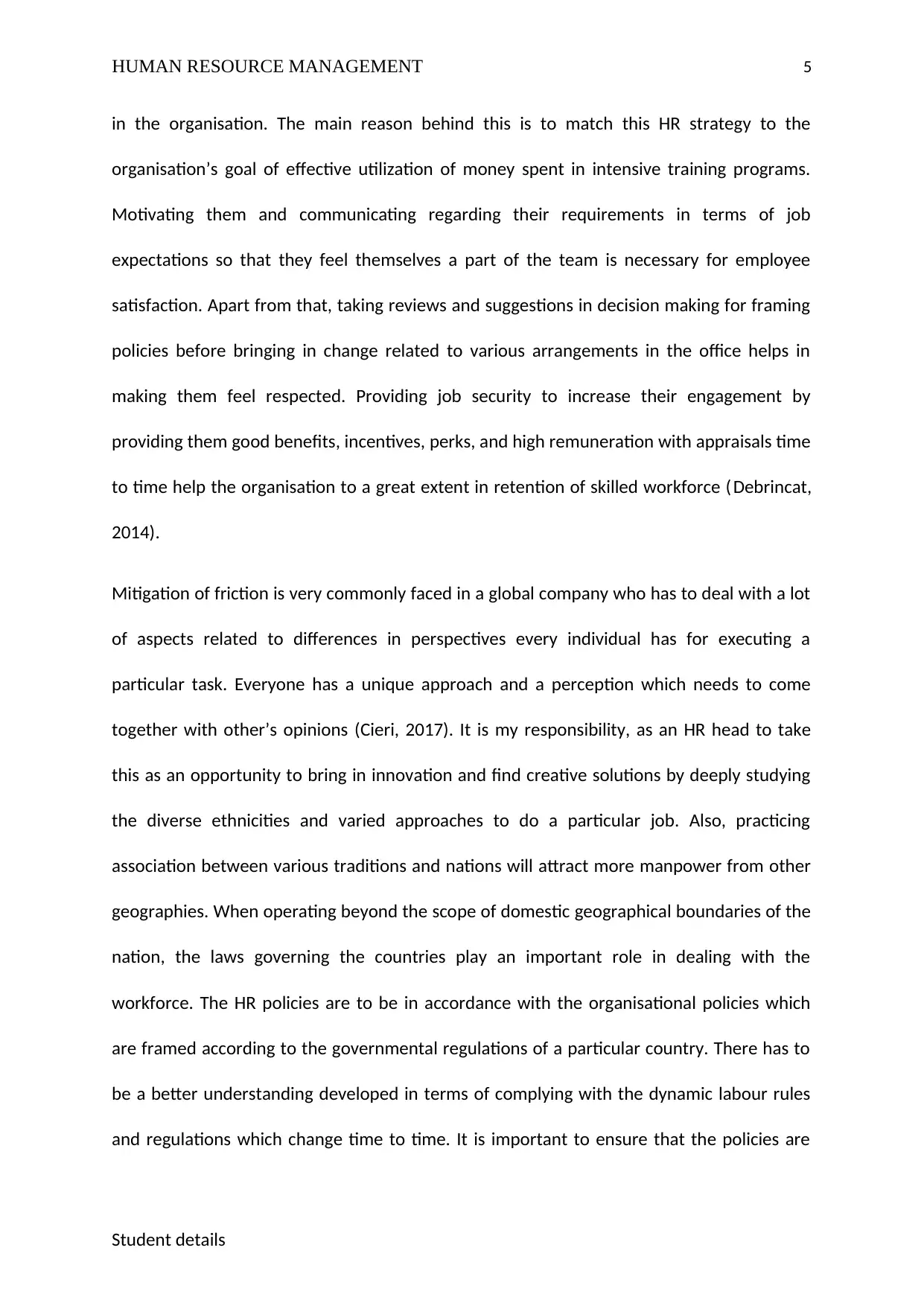
HUMAN RESOURCE MANAGEMENT 5
in the organisation. The main reason behind this is to match this HR strategy to the
organisation’s goal of effective utilization of money spent in intensive training programs.
Motivating them and communicating regarding their requirements in terms of job
expectations so that they feel themselves a part of the team is necessary for employee
satisfaction. Apart from that, taking reviews and suggestions in decision making for framing
policies before bringing in change related to various arrangements in the office helps in
making them feel respected. Providing job security to increase their engagement by
providing them good benefits, incentives, perks, and high remuneration with appraisals time
to time help the organisation to a great extent in retention of skilled workforce ( Debrincat,
2014).
Mitigation of friction is very commonly faced in a global company who has to deal with a lot
of aspects related to differences in perspectives every individual has for executing a
particular task. Everyone has a unique approach and a perception which needs to come
together with other’s opinions (Cieri, 2017). It is my responsibility, as an HR head to take
this as an opportunity to bring in innovation and find creative solutions by deeply studying
the diverse ethnicities and varied approaches to do a particular job. Also, practicing
association between various traditions and nations will attract more manpower from other
geographies. When operating beyond the scope of domestic geographical boundaries of the
nation, the laws governing the countries play an important role in dealing with the
workforce. The HR policies are to be in accordance with the organisational policies which
are framed according to the governmental regulations of a particular country. There has to
be a better understanding developed in terms of complying with the dynamic labour rules
and regulations which change time to time. It is important to ensure that the policies are
Student details
in the organisation. The main reason behind this is to match this HR strategy to the
organisation’s goal of effective utilization of money spent in intensive training programs.
Motivating them and communicating regarding their requirements in terms of job
expectations so that they feel themselves a part of the team is necessary for employee
satisfaction. Apart from that, taking reviews and suggestions in decision making for framing
policies before bringing in change related to various arrangements in the office helps in
making them feel respected. Providing job security to increase their engagement by
providing them good benefits, incentives, perks, and high remuneration with appraisals time
to time help the organisation to a great extent in retention of skilled workforce ( Debrincat,
2014).
Mitigation of friction is very commonly faced in a global company who has to deal with a lot
of aspects related to differences in perspectives every individual has for executing a
particular task. Everyone has a unique approach and a perception which needs to come
together with other’s opinions (Cieri, 2017). It is my responsibility, as an HR head to take
this as an opportunity to bring in innovation and find creative solutions by deeply studying
the diverse ethnicities and varied approaches to do a particular job. Also, practicing
association between various traditions and nations will attract more manpower from other
geographies. When operating beyond the scope of domestic geographical boundaries of the
nation, the laws governing the countries play an important role in dealing with the
workforce. The HR policies are to be in accordance with the organisational policies which
are framed according to the governmental regulations of a particular country. There has to
be a better understanding developed in terms of complying with the dynamic labour rules
and regulations which change time to time. It is important to ensure that the policies are
Student details
⊘ This is a preview!⊘
Do you want full access?
Subscribe today to unlock all pages.

Trusted by 1+ million students worldwide
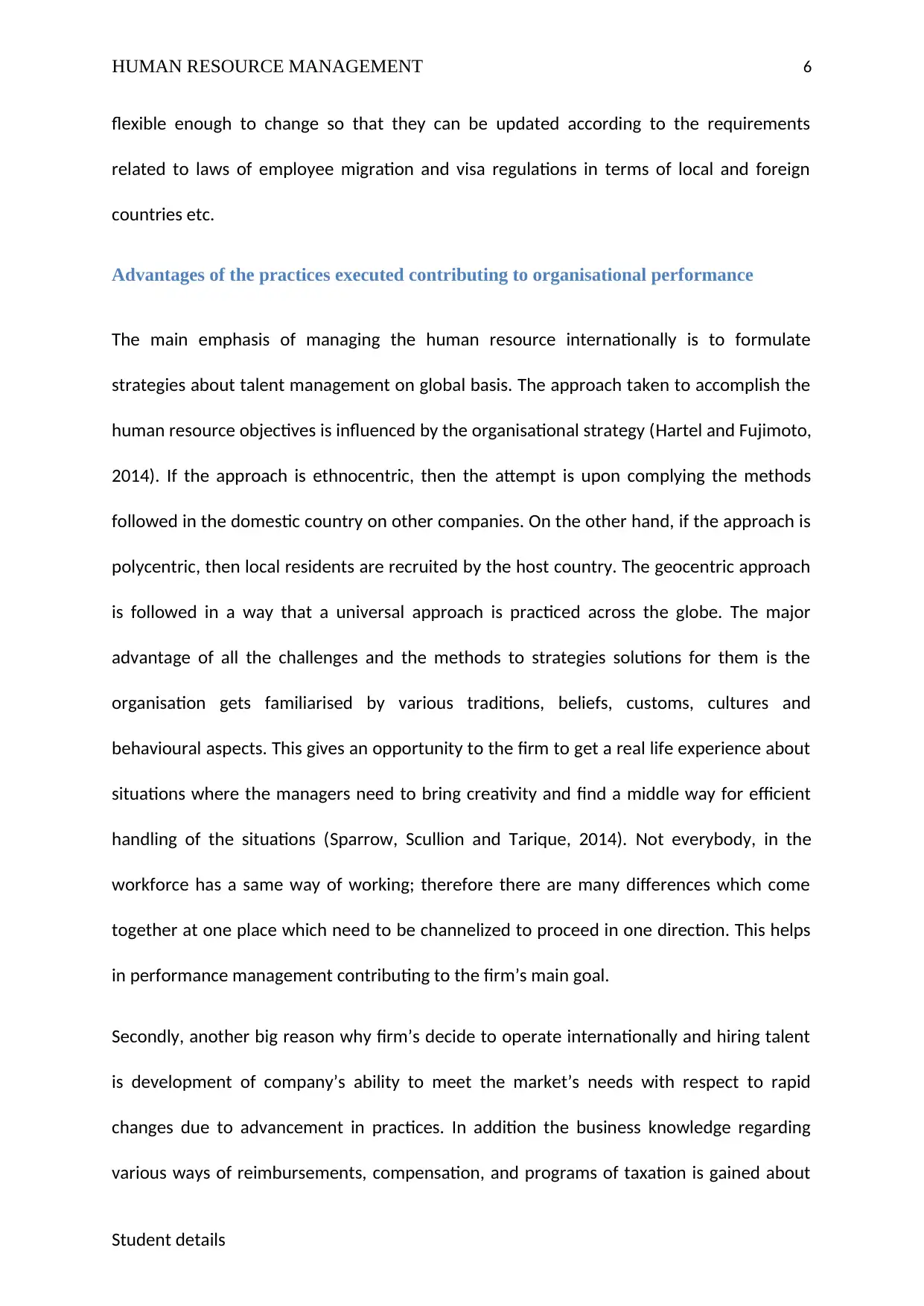
HUMAN RESOURCE MANAGEMENT 6
flexible enough to change so that they can be updated according to the requirements
related to laws of employee migration and visa regulations in terms of local and foreign
countries etc.
Advantages of the practices executed contributing to organisational performance
The main emphasis of managing the human resource internationally is to formulate
strategies about talent management on global basis. The approach taken to accomplish the
human resource objectives is influenced by the organisational strategy (Hartel and Fujimoto,
2014). If the approach is ethnocentric, then the attempt is upon complying the methods
followed in the domestic country on other companies. On the other hand, if the approach is
polycentric, then local residents are recruited by the host country. The geocentric approach
is followed in a way that a universal approach is practiced across the globe. The major
advantage of all the challenges and the methods to strategies solutions for them is the
organisation gets familiarised by various traditions, beliefs, customs, cultures and
behavioural aspects. This gives an opportunity to the firm to get a real life experience about
situations where the managers need to bring creativity and find a middle way for efficient
handling of the situations (Sparrow, Scullion and Tarique, 2014). Not everybody, in the
workforce has a same way of working; therefore there are many differences which come
together at one place which need to be channelized to proceed in one direction. This helps
in performance management contributing to the firm’s main goal.
Secondly, another big reason why firm’s decide to operate internationally and hiring talent
is development of company’s ability to meet the market’s needs with respect to rapid
changes due to advancement in practices. In addition the business knowledge regarding
various ways of reimbursements, compensation, and programs of taxation is gained about
Student details
flexible enough to change so that they can be updated according to the requirements
related to laws of employee migration and visa regulations in terms of local and foreign
countries etc.
Advantages of the practices executed contributing to organisational performance
The main emphasis of managing the human resource internationally is to formulate
strategies about talent management on global basis. The approach taken to accomplish the
human resource objectives is influenced by the organisational strategy (Hartel and Fujimoto,
2014). If the approach is ethnocentric, then the attempt is upon complying the methods
followed in the domestic country on other companies. On the other hand, if the approach is
polycentric, then local residents are recruited by the host country. The geocentric approach
is followed in a way that a universal approach is practiced across the globe. The major
advantage of all the challenges and the methods to strategies solutions for them is the
organisation gets familiarised by various traditions, beliefs, customs, cultures and
behavioural aspects. This gives an opportunity to the firm to get a real life experience about
situations where the managers need to bring creativity and find a middle way for efficient
handling of the situations (Sparrow, Scullion and Tarique, 2014). Not everybody, in the
workforce has a same way of working; therefore there are many differences which come
together at one place which need to be channelized to proceed in one direction. This helps
in performance management contributing to the firm’s main goal.
Secondly, another big reason why firm’s decide to operate internationally and hiring talent
is development of company’s ability to meet the market’s needs with respect to rapid
changes due to advancement in practices. In addition the business knowledge regarding
various ways of reimbursements, compensation, and programs of taxation is gained about
Student details
Paraphrase This Document
Need a fresh take? Get an instant paraphrase of this document with our AI Paraphraser
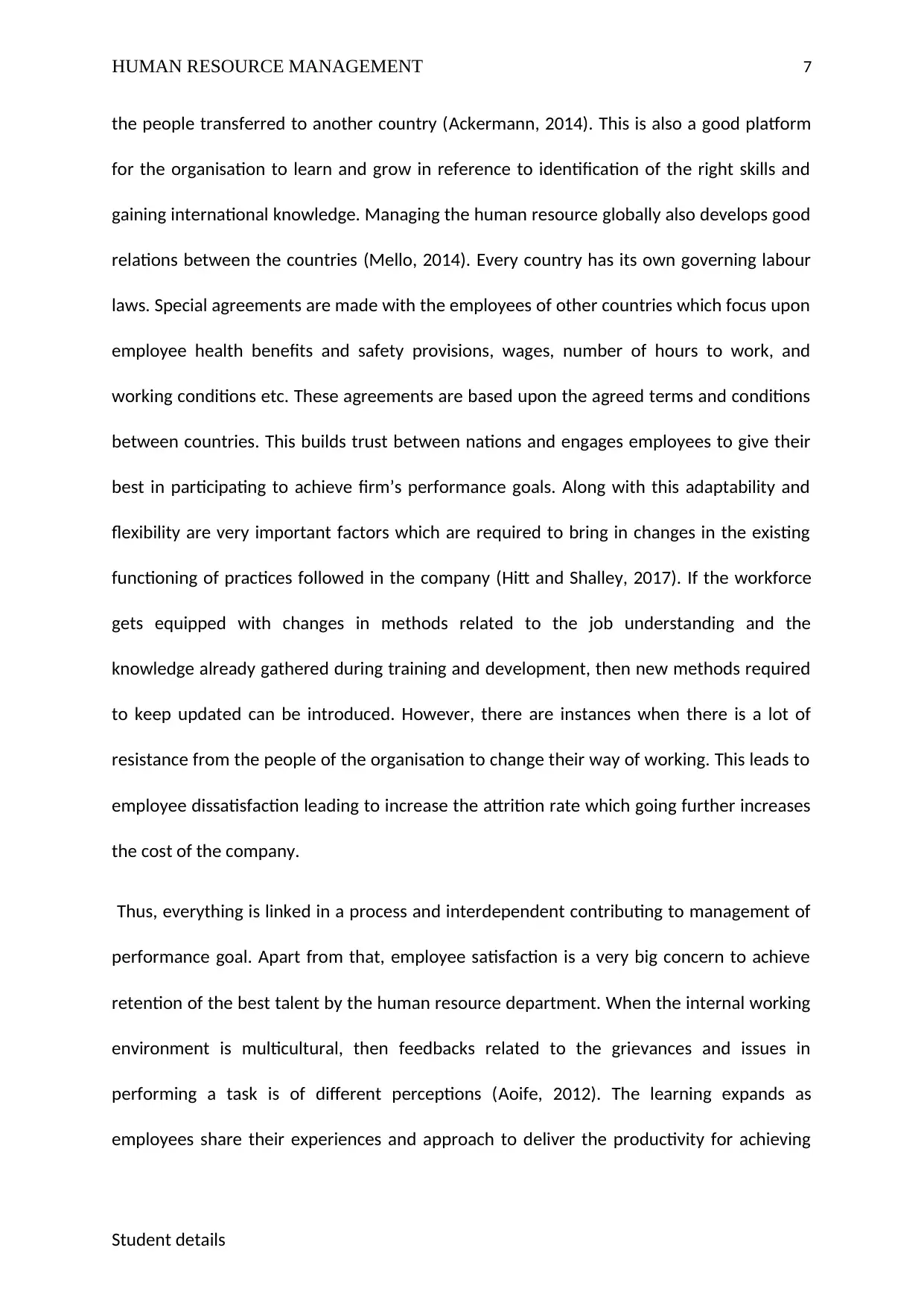
HUMAN RESOURCE MANAGEMENT 7
the people transferred to another country (Ackermann, 2014). This is also a good platform
for the organisation to learn and grow in reference to identification of the right skills and
gaining international knowledge. Managing the human resource globally also develops good
relations between the countries (Mello, 2014). Every country has its own governing labour
laws. Special agreements are made with the employees of other countries which focus upon
employee health benefits and safety provisions, wages, number of hours to work, and
working conditions etc. These agreements are based upon the agreed terms and conditions
between countries. This builds trust between nations and engages employees to give their
best in participating to achieve firm’s performance goals. Along with this adaptability and
flexibility are very important factors which are required to bring in changes in the existing
functioning of practices followed in the company (Hitt and Shalley, 2017). If the workforce
gets equipped with changes in methods related to the job understanding and the
knowledge already gathered during training and development, then new methods required
to keep updated can be introduced. However, there are instances when there is a lot of
resistance from the people of the organisation to change their way of working. This leads to
employee dissatisfaction leading to increase the attrition rate which going further increases
the cost of the company.
Thus, everything is linked in a process and interdependent contributing to management of
performance goal. Apart from that, employee satisfaction is a very big concern to achieve
retention of the best talent by the human resource department. When the internal working
environment is multicultural, then feedbacks related to the grievances and issues in
performing a task is of different perceptions (Aoife, 2012). The learning expands as
employees share their experiences and approach to deliver the productivity for achieving
Student details
the people transferred to another country (Ackermann, 2014). This is also a good platform
for the organisation to learn and grow in reference to identification of the right skills and
gaining international knowledge. Managing the human resource globally also develops good
relations between the countries (Mello, 2014). Every country has its own governing labour
laws. Special agreements are made with the employees of other countries which focus upon
employee health benefits and safety provisions, wages, number of hours to work, and
working conditions etc. These agreements are based upon the agreed terms and conditions
between countries. This builds trust between nations and engages employees to give their
best in participating to achieve firm’s performance goals. Along with this adaptability and
flexibility are very important factors which are required to bring in changes in the existing
functioning of practices followed in the company (Hitt and Shalley, 2017). If the workforce
gets equipped with changes in methods related to the job understanding and the
knowledge already gathered during training and development, then new methods required
to keep updated can be introduced. However, there are instances when there is a lot of
resistance from the people of the organisation to change their way of working. This leads to
employee dissatisfaction leading to increase the attrition rate which going further increases
the cost of the company.
Thus, everything is linked in a process and interdependent contributing to management of
performance goal. Apart from that, employee satisfaction is a very big concern to achieve
retention of the best talent by the human resource department. When the internal working
environment is multicultural, then feedbacks related to the grievances and issues in
performing a task is of different perceptions (Aoife, 2012). The learning expands as
employees share their experiences and approach to deliver the productivity for achieving
Student details
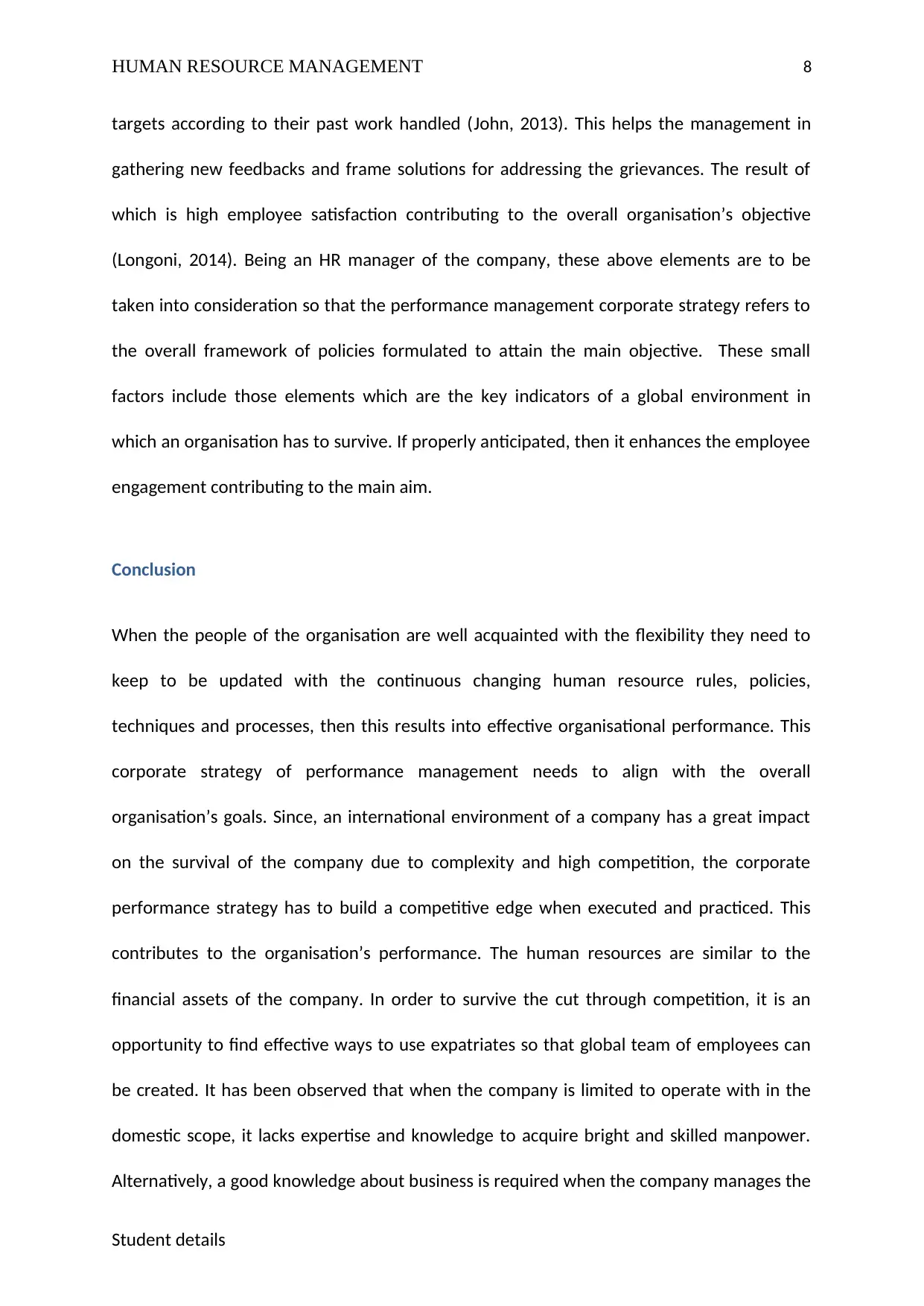
HUMAN RESOURCE MANAGEMENT 8
targets according to their past work handled (John, 2013). This helps the management in
gathering new feedbacks and frame solutions for addressing the grievances. The result of
which is high employee satisfaction contributing to the overall organisation’s objective
(Longoni, 2014). Being an HR manager of the company, these above elements are to be
taken into consideration so that the performance management corporate strategy refers to
the overall framework of policies formulated to attain the main objective. These small
factors include those elements which are the key indicators of a global environment in
which an organisation has to survive. If properly anticipated, then it enhances the employee
engagement contributing to the main aim.
Conclusion
When the people of the organisation are well acquainted with the flexibility they need to
keep to be updated with the continuous changing human resource rules, policies,
techniques and processes, then this results into effective organisational performance. This
corporate strategy of performance management needs to align with the overall
organisation’s goals. Since, an international environment of a company has a great impact
on the survival of the company due to complexity and high competition, the corporate
performance strategy has to build a competitive edge when executed and practiced. This
contributes to the organisation’s performance. The human resources are similar to the
financial assets of the company. In order to survive the cut through competition, it is an
opportunity to find effective ways to use expatriates so that global team of employees can
be created. It has been observed that when the company is limited to operate with in the
domestic scope, it lacks expertise and knowledge to acquire bright and skilled manpower.
Alternatively, a good knowledge about business is required when the company manages the
Student details
targets according to their past work handled (John, 2013). This helps the management in
gathering new feedbacks and frame solutions for addressing the grievances. The result of
which is high employee satisfaction contributing to the overall organisation’s objective
(Longoni, 2014). Being an HR manager of the company, these above elements are to be
taken into consideration so that the performance management corporate strategy refers to
the overall framework of policies formulated to attain the main objective. These small
factors include those elements which are the key indicators of a global environment in
which an organisation has to survive. If properly anticipated, then it enhances the employee
engagement contributing to the main aim.
Conclusion
When the people of the organisation are well acquainted with the flexibility they need to
keep to be updated with the continuous changing human resource rules, policies,
techniques and processes, then this results into effective organisational performance. This
corporate strategy of performance management needs to align with the overall
organisation’s goals. Since, an international environment of a company has a great impact
on the survival of the company due to complexity and high competition, the corporate
performance strategy has to build a competitive edge when executed and practiced. This
contributes to the organisation’s performance. The human resources are similar to the
financial assets of the company. In order to survive the cut through competition, it is an
opportunity to find effective ways to use expatriates so that global team of employees can
be created. It has been observed that when the company is limited to operate with in the
domestic scope, it lacks expertise and knowledge to acquire bright and skilled manpower.
Alternatively, a good knowledge about business is required when the company manages the
Student details
⊘ This is a preview!⊘
Do you want full access?
Subscribe today to unlock all pages.

Trusted by 1+ million students worldwide
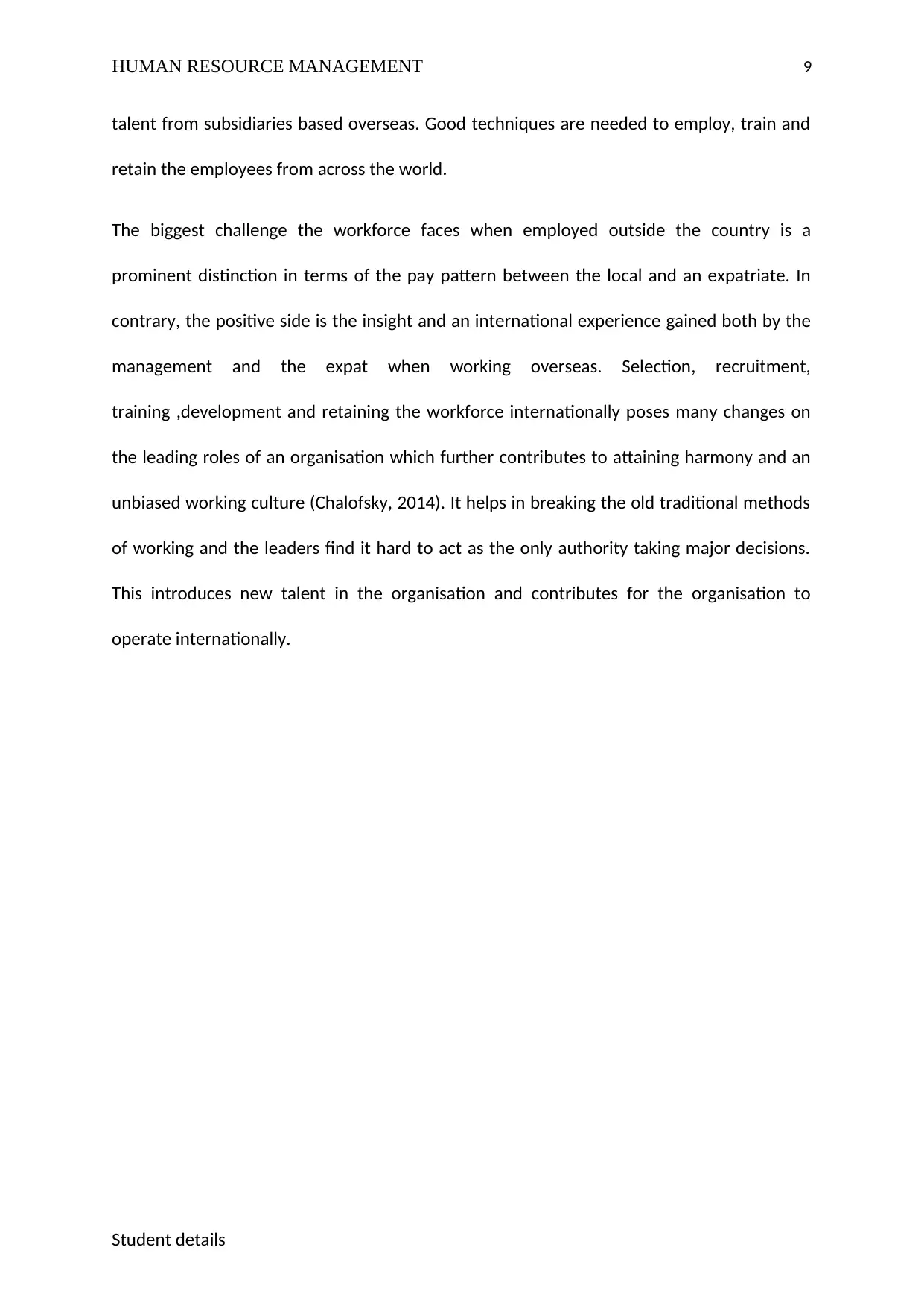
HUMAN RESOURCE MANAGEMENT 9
talent from subsidiaries based overseas. Good techniques are needed to employ, train and
retain the employees from across the world.
The biggest challenge the workforce faces when employed outside the country is a
prominent distinction in terms of the pay pattern between the local and an expatriate. In
contrary, the positive side is the insight and an international experience gained both by the
management and the expat when working overseas. Selection, recruitment,
training ,development and retaining the workforce internationally poses many changes on
the leading roles of an organisation which further contributes to attaining harmony and an
unbiased working culture (Chalofsky, 2014). It helps in breaking the old traditional methods
of working and the leaders find it hard to act as the only authority taking major decisions.
This introduces new talent in the organisation and contributes for the organisation to
operate internationally.
Student details
talent from subsidiaries based overseas. Good techniques are needed to employ, train and
retain the employees from across the world.
The biggest challenge the workforce faces when employed outside the country is a
prominent distinction in terms of the pay pattern between the local and an expatriate. In
contrary, the positive side is the insight and an international experience gained both by the
management and the expat when working overseas. Selection, recruitment,
training ,development and retaining the workforce internationally poses many changes on
the leading roles of an organisation which further contributes to attaining harmony and an
unbiased working culture (Chalofsky, 2014). It helps in breaking the old traditional methods
of working and the leaders find it hard to act as the only authority taking major decisions.
This introduces new talent in the organisation and contributes for the organisation to
operate internationally.
Student details
Paraphrase This Document
Need a fresh take? Get an instant paraphrase of this document with our AI Paraphraser
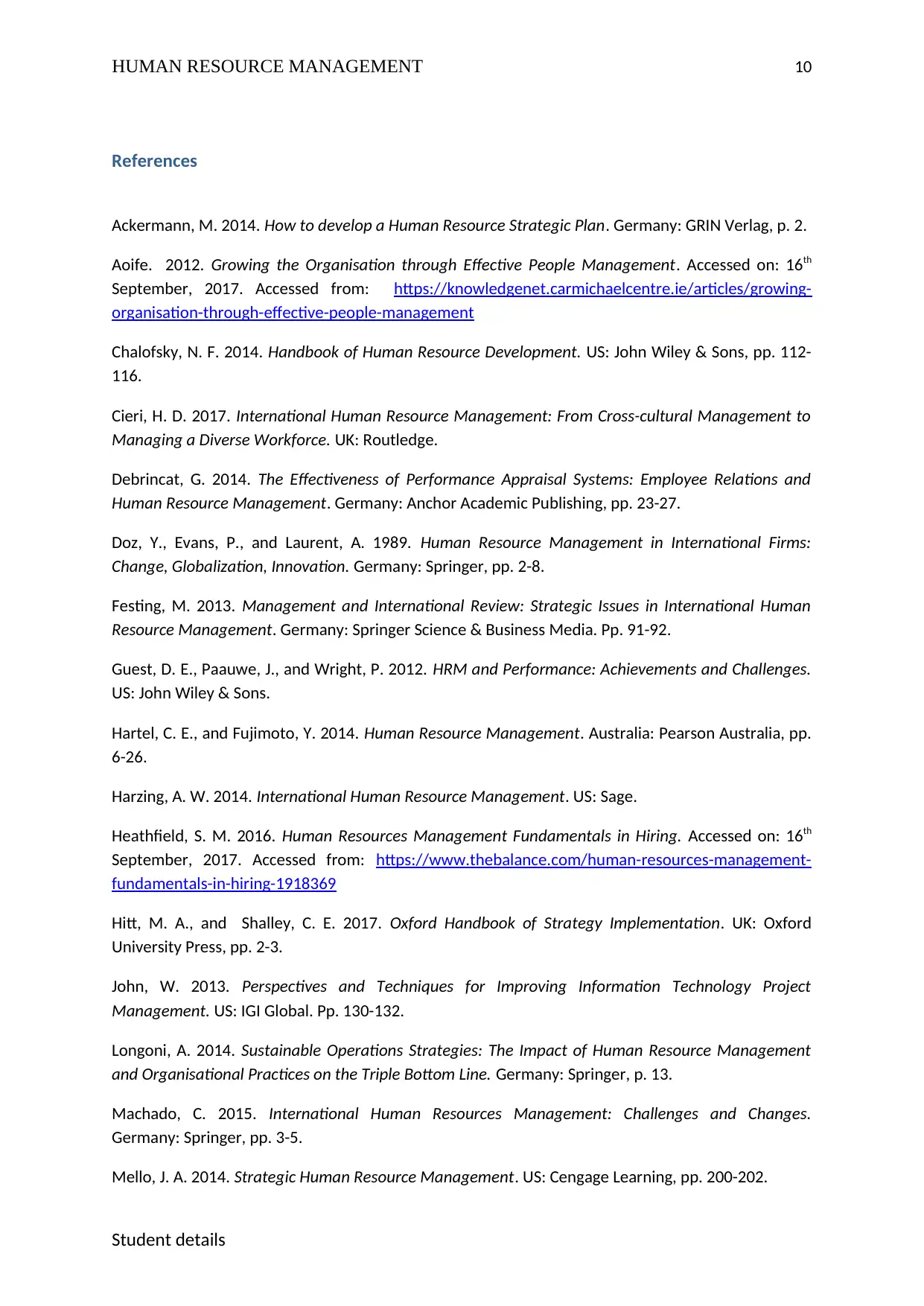
HUMAN RESOURCE MANAGEMENT 10
References
Ackermann, M. 2014. How to develop a Human Resource Strategic Plan. Germany: GRIN Verlag, p. 2.
Aoife. 2012. Growing the Organisation through Effective People Management. Accessed on: 16th
September, 2017. Accessed from: https://knowledgenet.carmichaelcentre.ie/articles/growing-
organisation-through-effective-people-management
Chalofsky, N. F. 2014. Handbook of Human Resource Development. US: John Wiley & Sons, pp. 112-
116.
Cieri, H. D. 2017. International Human Resource Management: From Cross-cultural Management to
Managing a Diverse Workforce. UK: Routledge.
Debrincat, G. 2014. The Effectiveness of Performance Appraisal Systems: Employee Relations and
Human Resource Management. Germany: Anchor Academic Publishing, pp. 23-27.
Doz, Y., Evans, P., and Laurent, A. 1989. Human Resource Management in International Firms:
Change, Globalization, Innovation. Germany: Springer, pp. 2-8.
Festing, M. 2013. Management and International Review: Strategic Issues in International Human
Resource Management. Germany: Springer Science & Business Media. Pp. 91-92.
Guest, D. E., Paauwe, J., and Wright, P. 2012. HRM and Performance: Achievements and Challenges.
US: John Wiley & Sons.
Hartel, C. E., and Fujimoto, Y. 2014. Human Resource Management. Australia: Pearson Australia, pp.
6-26.
Harzing, A. W. 2014. International Human Resource Management. US: Sage.
Heathfield, S. M. 2016. Human Resources Management Fundamentals in Hiring. Accessed on: 16th
September, 2017. Accessed from: https://www.thebalance.com/human-resources-management-
fundamentals-in-hiring-1918369
Hitt, M. A., and Shalley, C. E. 2017. Oxford Handbook of Strategy Implementation. UK: Oxford
University Press, pp. 2-3.
John, W. 2013. Perspectives and Techniques for Improving Information Technology Project
Management. US: IGI Global. Pp. 130-132.
Longoni, A. 2014. Sustainable Operations Strategies: The Impact of Human Resource Management
and Organisational Practices on the Triple Bottom Line. Germany: Springer, p. 13.
Machado, C. 2015. International Human Resources Management: Challenges and Changes.
Germany: Springer, pp. 3-5.
Mello, J. A. 2014. Strategic Human Resource Management. US: Cengage Learning, pp. 200-202.
Student details
References
Ackermann, M. 2014. How to develop a Human Resource Strategic Plan. Germany: GRIN Verlag, p. 2.
Aoife. 2012. Growing the Organisation through Effective People Management. Accessed on: 16th
September, 2017. Accessed from: https://knowledgenet.carmichaelcentre.ie/articles/growing-
organisation-through-effective-people-management
Chalofsky, N. F. 2014. Handbook of Human Resource Development. US: John Wiley & Sons, pp. 112-
116.
Cieri, H. D. 2017. International Human Resource Management: From Cross-cultural Management to
Managing a Diverse Workforce. UK: Routledge.
Debrincat, G. 2014. The Effectiveness of Performance Appraisal Systems: Employee Relations and
Human Resource Management. Germany: Anchor Academic Publishing, pp. 23-27.
Doz, Y., Evans, P., and Laurent, A. 1989. Human Resource Management in International Firms:
Change, Globalization, Innovation. Germany: Springer, pp. 2-8.
Festing, M. 2013. Management and International Review: Strategic Issues in International Human
Resource Management. Germany: Springer Science & Business Media. Pp. 91-92.
Guest, D. E., Paauwe, J., and Wright, P. 2012. HRM and Performance: Achievements and Challenges.
US: John Wiley & Sons.
Hartel, C. E., and Fujimoto, Y. 2014. Human Resource Management. Australia: Pearson Australia, pp.
6-26.
Harzing, A. W. 2014. International Human Resource Management. US: Sage.
Heathfield, S. M. 2016. Human Resources Management Fundamentals in Hiring. Accessed on: 16th
September, 2017. Accessed from: https://www.thebalance.com/human-resources-management-
fundamentals-in-hiring-1918369
Hitt, M. A., and Shalley, C. E. 2017. Oxford Handbook of Strategy Implementation. UK: Oxford
University Press, pp. 2-3.
John, W. 2013. Perspectives and Techniques for Improving Information Technology Project
Management. US: IGI Global. Pp. 130-132.
Longoni, A. 2014. Sustainable Operations Strategies: The Impact of Human Resource Management
and Organisational Practices on the Triple Bottom Line. Germany: Springer, p. 13.
Machado, C. 2015. International Human Resources Management: Challenges and Changes.
Germany: Springer, pp. 3-5.
Mello, J. A. 2014. Strategic Human Resource Management. US: Cengage Learning, pp. 200-202.
Student details
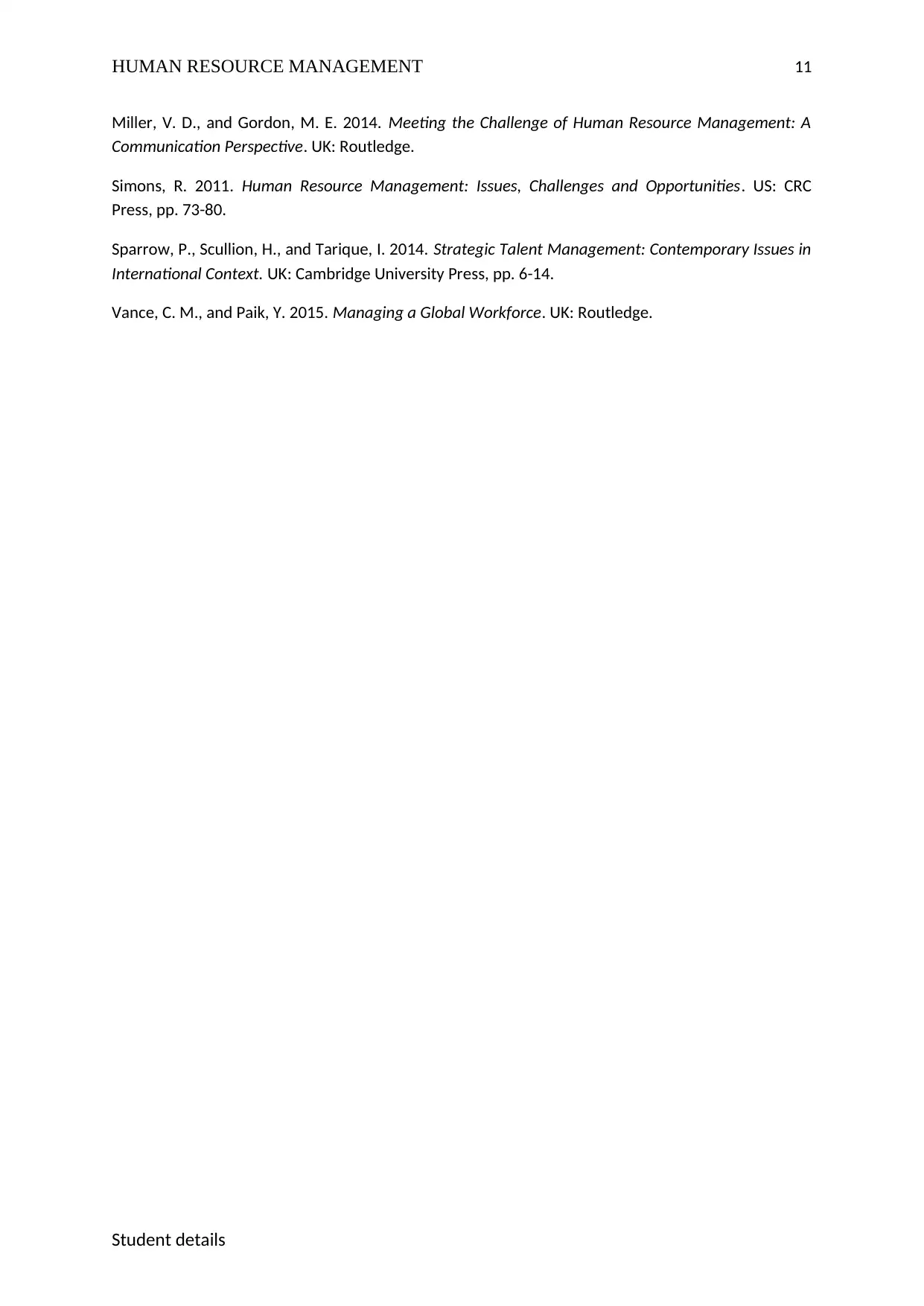
HUMAN RESOURCE MANAGEMENT 11
Miller, V. D., and Gordon, M. E. 2014. Meeting the Challenge of Human Resource Management: A
Communication Perspective. UK: Routledge.
Simons, R. 2011. Human Resource Management: Issues, Challenges and Opportunities. US: CRC
Press, pp. 73-80.
Sparrow, P., Scullion, H., and Tarique, I. 2014. Strategic Talent Management: Contemporary Issues in
International Context. UK: Cambridge University Press, pp. 6-14.
Vance, C. M., and Paik, Y. 2015. Managing a Global Workforce. UK: Routledge.
Student details
Miller, V. D., and Gordon, M. E. 2014. Meeting the Challenge of Human Resource Management: A
Communication Perspective. UK: Routledge.
Simons, R. 2011. Human Resource Management: Issues, Challenges and Opportunities. US: CRC
Press, pp. 73-80.
Sparrow, P., Scullion, H., and Tarique, I. 2014. Strategic Talent Management: Contemporary Issues in
International Context. UK: Cambridge University Press, pp. 6-14.
Vance, C. M., and Paik, Y. 2015. Managing a Global Workforce. UK: Routledge.
Student details
⊘ This is a preview!⊘
Do you want full access?
Subscribe today to unlock all pages.

Trusted by 1+ million students worldwide
1 out of 12
Related Documents
Your All-in-One AI-Powered Toolkit for Academic Success.
+13062052269
info@desklib.com
Available 24*7 on WhatsApp / Email
![[object Object]](/_next/static/media/star-bottom.7253800d.svg)
Unlock your academic potential
Copyright © 2020–2025 A2Z Services. All Rights Reserved. Developed and managed by ZUCOL.





